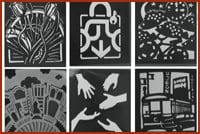So the votes are in and the gay images are, for the most part, out.
The Bank St bike rack art project was good in theory, as it was an opportunity for the queer community to get some self-identifiable images out on the streets — in addition to the rainbow flags that the community is insisting on.
It didn’t quite work out that way though — out of the final 30 designs that were selected by a committee to be put onto the new bike racks, only two ended up even remotely representing the queer community.
While the list of winners hasn’t been released yet to the public, Capital Xtra was told that those two designs are: an abstract picture with triangles in it, and an image of a silhouette of two women with hearts on their chests which could be interpreted as representing a lesbian relationship.
Jeremy Dias, executive director of youth diversity initiative Jer’s Vision, thinks that this is just not good enough.
“These bike racks were supposed to represent our community and they didn’t,” says Dias.
A miscommunication between Dias and the City of Ottawa resulted in one artist from Jer’s Vision producing approximately 50 designs for the contest — only to find out that only two images could be submitted per entrant, with no special exceptions for group entries.
In the end, neither of the images submitted by the member of Jer’s Vision, were picked to be in the top 30.
The selection committee “is participating in systemic discrimination by not displaying queer images in public spaces,” says Dias
“Why do we have to work so hard to make this a [visible] gay village?”
In an email to Colleen Hendrick, director of the city’s cultural services and community funding branch, Dias expressed concern about the lack of queer images, and urged the city to re-consider their selections.
“The committee should have realized that their efforts to recruit queer art failed and should have made additional attempts,” he wrote.
Glenn Crawford was the gay representative on the selection committee. Crawford is a well-known designer, artist and also represented the gay community on the public committee that considered the reconstruction of Bank St. He took a high profile in encouraging the community to submit gay-themed designs for the bike racks.
Crawford admits that he was disappointed with the lack of queer designs included in the submissions, but says the lack of queer-themed finalists is attributable to a low quantity and quality of submissions with a queer theme.
“Some of the designs submitted [that we later found out were done by a queer artist] were ambiguous and not really clear about being GLBTQ,” says Crawford.
“After really looking closely at some of them, I kind of got their symbolism — but if I’m a [gay] person on a judging panel and the message is not clear to me, then it definitely won’t be to other people.”
Crawford says that when he agreed to be on the judging panel he was hoping that some of the designs he would be choosing from would specifically signify Ottawa’s gay community.
“I was thinking along the lines of things like same-sex marriage, community groups, or protests on Parliament Hill,” he says.
“Designs like that with obvious symbolism would have made me really excited — that’s why I really responded to the [design] with the triangles.”
While Dias is upset with the outcome of this project, Crawford says that the process was a fair one. “I feel that I did everything I could to have [gay] themed images included, and the City did everything they could to try and include us,” says Crawford.
Nicole Zuger, program manager and arts developer with the city of Ottawa says that she does understand Dias’s concerns but that it is too late to have a re-call for submission.
“We’re part of an overall roadway project and we have no control over deadlines,” says Zuger.
She says that while discussions about the bike rack art project may be over, it is just the beginning of a dialogue the city is willing to have with those wishing to incorporate queer images onto Bank street through public art.
City officials wish to sit down with Dias to discuss possible opportunities for themed art outside of the public art program, such as art workshop, or a possible queer-themed sculpture or mural.
“There is public art money available,” Crawford reminds people.
“So, if we are interested in creating a separate art project and we come up with a specific proposal and go to the city with it, then there is a possible opportunity for a mural,” he says.
So while Crawford acknowledges a missed opportunity in submitting artwork for the bike rack project, he says this is a perfect time to come up with an alternate solution to the lack of queer images on Bank Street.
The city is also encouraging.
“Art can be a vehicle to take messages out to the people, but it won’t start making an impact until people respond to it, and start coming to the table,” says Zuger.
“Now that people are actually talking about the lack of queer images, we might be able to actually create something in the future.”

 Why you can trust Xtra
Why you can trust Xtra


